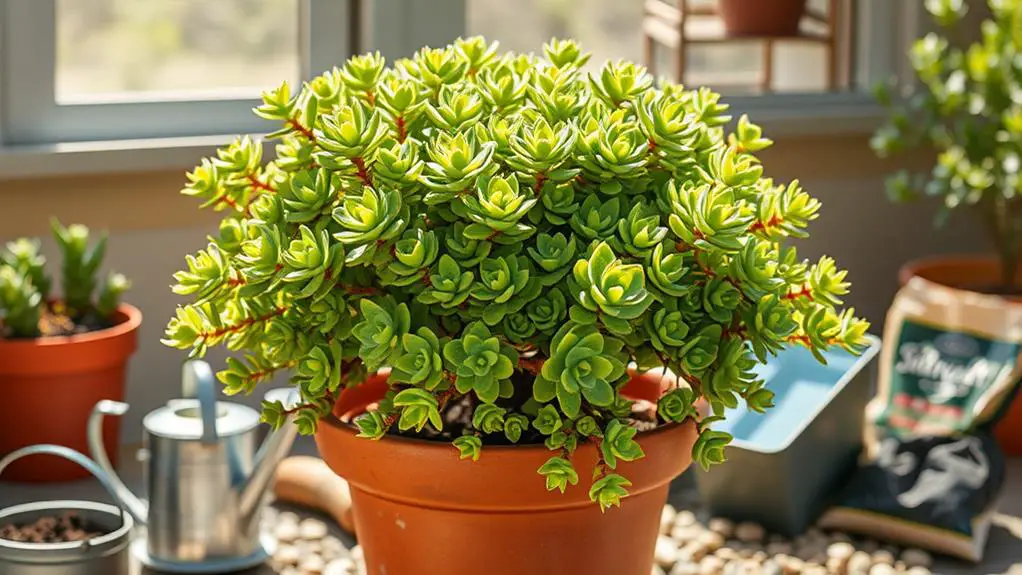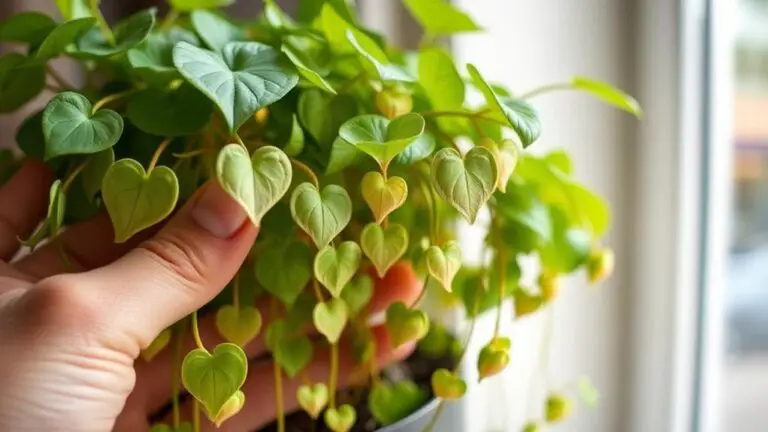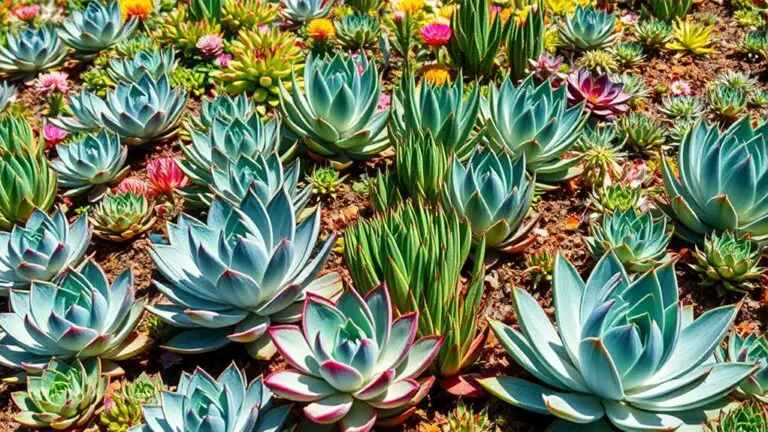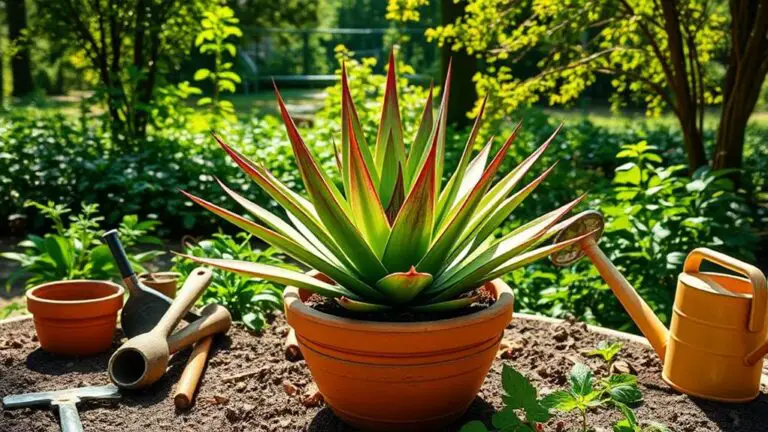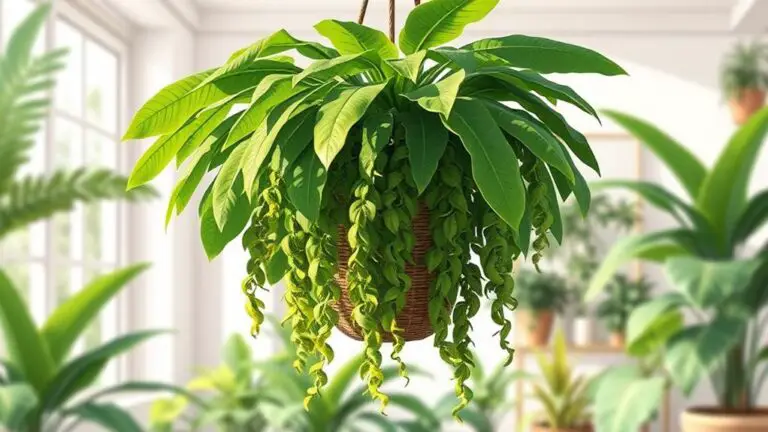9 Essential Tips for Elephant Bush Care
When caring for an Elephant Bush, you'll find that proper soil and sunlight are just the beginning. You might wonder, what kind of soil works best, and how much sunlight is truly ideal? The answers to these questions are vital in ensuring your plant thrives. You'll also need to master the art of watering and understand the importance of temperature control. But that's not all—pruning, pest control, and propagation techniques also play key roles. Ready to transform your Elephant Bush into a stunning centerpiece? Let's explore these essential tips further.
Ideal Soil Composition
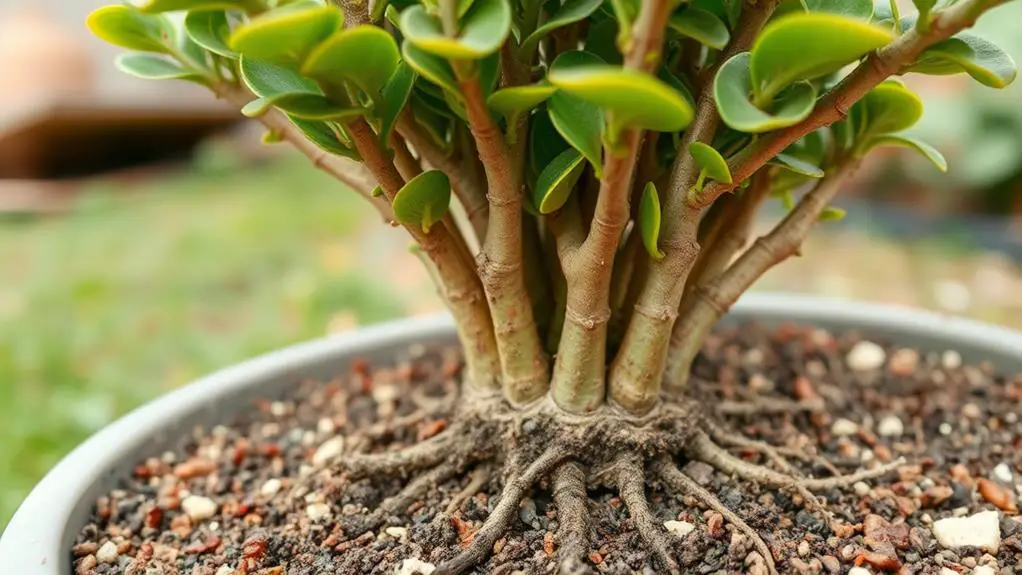
Ever wondered what kind of soil an elephant bush needs to thrive? To guarantee your elephant bush grows strong and healthy, you'll need to replicate its native desert conditions. This plant thrives in sandy, rocky, and well-draining soil. Such a soil mixture is vital for providing the right environment for its roots.
Start by choosing a loose, nutrient-rich potting mix specifically formulated for succulents and cacti. This type of potting mix maintains the correct moisture balance, preventing the roots from sitting in water.
To enhance drainage even further, mix equal parts of perlite, coarse sand, and potting soil. This combination guarantees air circulation around the roots, which is essential for preventing root rot.
When you're planting your elephant bush in a container, always use pots with drainage holes. These holes allow excess water to escape, keeping the soil from becoming too wet.
Root rot can quickly damage your plant if the soil retains too much water, so good drainage is key.
Light Requirements

To guarantee your Elephant Bush thrives, place it where it can get at least 6 hours of bright, direct sunlight each day.
If you're growing it indoors, a south, east, or west-facing window is ideal to maximize light.
Be cautious with temperature, keeping it between 65°F and 80°F, and gradually introduce it to more sunlight to avoid leaf scorch.
Optimal Sunlight Duration
A crucial aspect of caring for an elephant bush (Portulacaria afra) is ensuring it gets ample sunlight. The Elephant Bush thrives best in bright direct sunlight, needing at least six hours of exposure daily for ideal growth. Without enough light, you might notice stunted growth and leggy stems, which isn't what you want for your plant.
If you're growing your Elephant Bush indoors, placing it near south, east, or west-facing windows is perfect. These spots typically get plenty of light throughout the day, helping your plant stay healthy and vibrant.
However, it's important to acclimate your plant gradually to direct sunlight, especially if it's been in lower light conditions. Sudden exposure can cause leaf scorch, which can harm your plant.
Consistent bright light not only promotes healthy growth but also enhances the vibrant color of the leaves, making your plant look even more appealing.
Indoor Light Placement
Understanding the importance of sunlight for your Elephant Bush, let's focus on how to achieve the best indoor light placement. To guarantee your plant thrives, aim for bright light exposure. Placing your Elephant Bush near south, east, or west-facing windows is ideal. These locations provide the necessary 5-6 hours of full sun daily, which is essential for peak growth and health.
Although this plant can tolerate partial shade, prolonged low light can lead to stunted growth and leggy stems. If you notice your Elephant Bush stretching towards the light or its leaves dropping, it mightn't be getting enough bright light.
Remember to rotate your plant regularly. This simple practice promotes even light distribution, preventing uneven growth and keeping your plant looking balanced and healthy.
If you see signs of leaf scorching, don't worry! Gradually acclimate your plant to full sun exposure. Start by placing it in indirect sunlight, then slowly increase its time in direct sunlight. This approach helps avoid stress and damage to the leaves.
Temperature Sensitivity
Your Elephant Bush thrives in temperatures between 65°F and 80°F (18°C to 27°C), with these conditions being fundamental for its ideal growth and health.
It's essential to understand the temperature sensitivity of your plant. While it can handle high heat up to 100°F (38°C), temperatures below 60°F (15°C) can harm it. Protecting your Elephant Bush from cold is critical for preventing damage.
To support best growth, make sure your plant gets enough light. It prefers bright direct sunlight for at least 5-6 hours each day. Gradually acclimate it to this light level to avoid leaf scorch.
Without enough light, you might notice stunted growth and leaf drop.
Here are some practical tips:
- Position your plant near south, east, or west-facing windows.
- Regularly monitor light conditions to prevent yellowing leaves.
- Be mindful of cold drafts from windows or doors.
- Consider using grow lights if natural light is insufficient.
Watering Guidelines
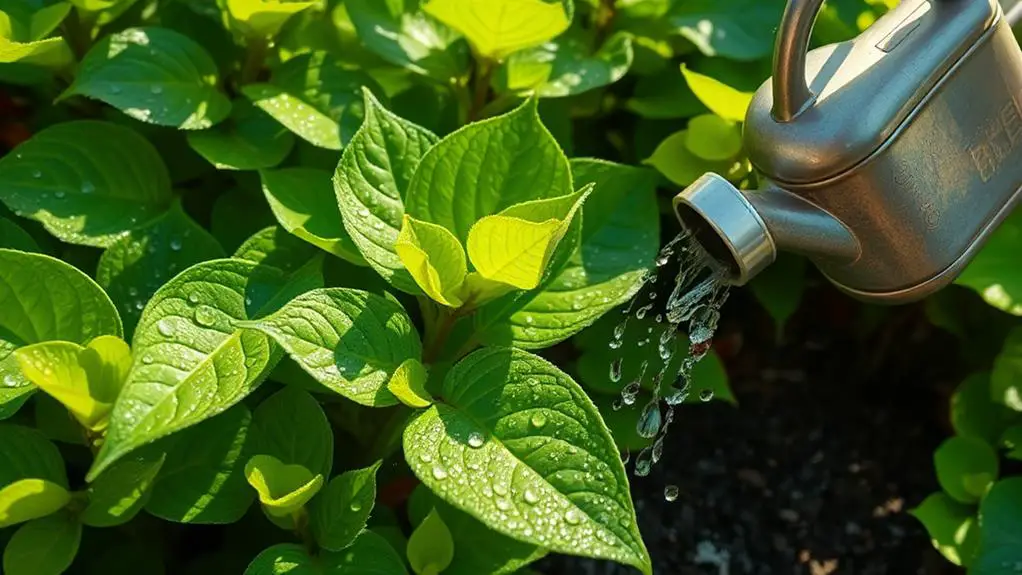
Proper watering is vital for the health of your Elephant Bush. To guarantee your plant thrives, water the plant every 2-3 weeks during the growing season. It's imperative to let the soil dry completely before you water again. This helps prevent overwatering, which can lead to root rot, often indicated by yellowing leaves.
Establishing a consistent watering schedule can make a considerable difference. Always check the soil moisture level before watering. You can do this by feeling the soil with your finger. If it's dry to the touch, it's time to water.
Use room temperature water to avoid shocking the plant. Water deeply, allowing any excess to drain entirely.
During the winter months, your Elephant Bush enters dormancy and needs much less water. Reduce the watering frequency dramatically, and only water when the soil is thoroughly dry.
This seasonal adjustment helps the plant rest and prepare for the next growing season.
Temperature Preferences
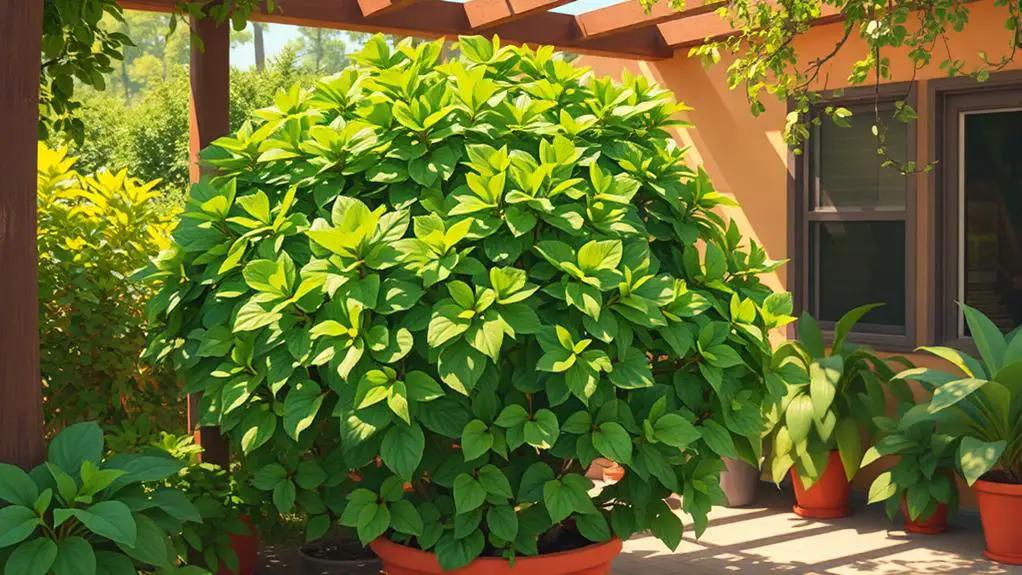
When it comes to temperature, your elephant bush will flourish between 65°F and 80°F.
It's essential to protect it from cold weather, as temperatures below 60°F can cause stress.
For the best results, keep your plant near a bright window and guarantee a stable environment without sudden temperature changes.
Optimal Temperature Range
For ideal growth, the Elephant Bush thrives best within a temperature range of 65°F to 80°F (18°C to 27°C). Keeping the temperatures in this preferred range guarantees your plant stays healthy and grows well.
Consistent warmth is essential for the Elephant Bush as it mimics its native environment. Rapid temperature fluctuations can stress the plant, so maintaining a stable indoor climate is key.
To help your Elephant Bush flourish, remember these tips:
- Protect the plant from temperatures below 60°F (15°C).
- Avoid placing it near drafts or doors that could expose it to cold air.
- Keep it away from heat sources like radiators that can cause sudden temperature changes.
- Confirm the room maintains consistent warmth throughout the day and night.
Cold Weather Precautions
How can you confirm your Elephant Bush remains healthy during cold weather?
First, understand that Elephant Bush thrives in temperatures between 65°F and 80°F. Cold temperatures below 60°F can stress your plant. If you live in hardiness zones 9-11, you can grow it outdoors, but make sure it's in a sheltered location to protect it from harsh winter winds.
For these regions, positioning your plant wisely can make a big difference.
When cold weather approaches, it's essential to bring your Elephant Bush indoors to prevent damage or death from freezing temperatures. Place it near a bright window to make certain it gets enough light and warmth. Sudden temperature changes or cold drafts can cause leaf drop, so keep your plant away from doors and windows that often open.
If you're growing your Elephant Bush indoors year-round, maintaining a stable environment is key. Verify it's not exposed to cold air from air conditioners or open windows.
Pruning Techniques
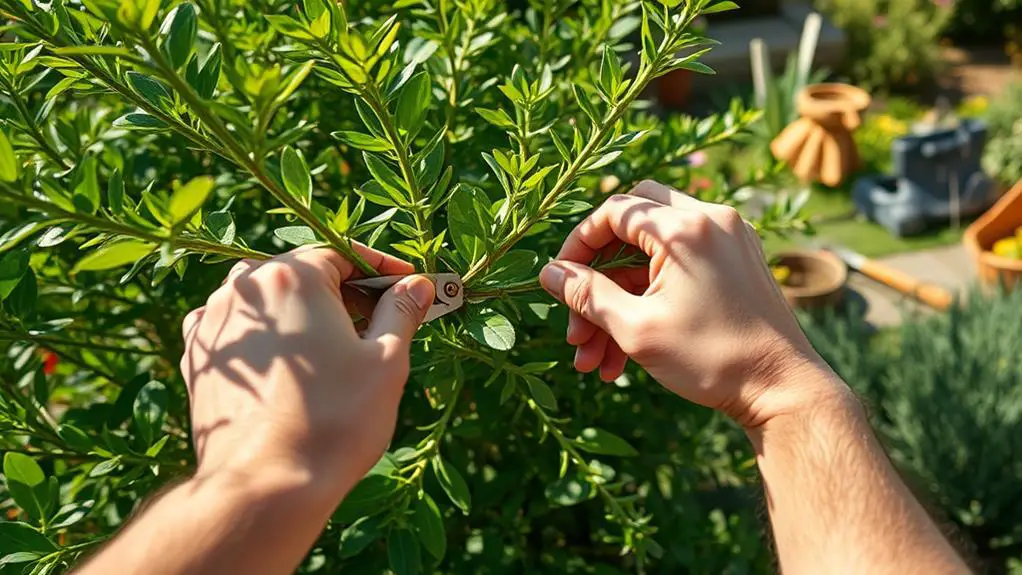
Pruning your Elephant Bush, also known as Portulacaria afra, is crucial for maintaining its shape and promoting bushier growth. Regular pruning helps you keep the plant looking neat and encourages healthy growth. It's best to prune the plant during the growing season, typically in late spring or early summer.
Use sterilized pruning tools to remove any damaged, dead, or diseased leaves and branches. This helps prevent the spread of pests and diseases, guaranteeing your plant stays healthy.
When you prune back leggy growth, it promotes better air circulation and allows more light to reach all parts of the plant.
Here's a quick guide:
- Use sterilized pruning tools: Clean tools prevent the spread of diseases.
- Remove damaged or dead sections: This keeps the plant healthy and attractive.
- Prune leggy growth: Encourages bushier, healthier growth.
- Practice bonsai techniques: Shape the plant creatively and control its size.
Remember to dispose of any diseased sections promptly. This helps maintain the overall health of your Elephant Bush.
Regular pruning not only keeps the plant looking good but also guarantees it thrives for years to come. Happy gardening!
Pest and Disease Control
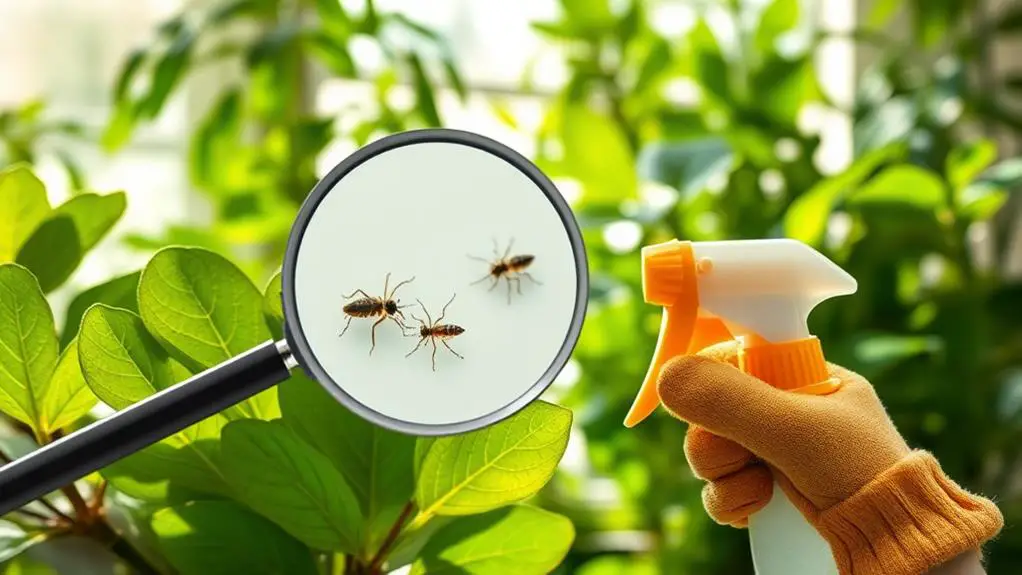
Keeping your Elephant Bush healthy requires vigilance against pests and diseases. Regularly inspect your plant for common pests like spider mites, mealybugs, and aphids. Early detection is key. If you catch them early, treating with neem oil or insecticidal soap can save your plant. Follow the manufacturer's instructions to avoid harming your Elephant Bush.
Proper watering practices are essential to prevent root rot, the primary disease affecting Elephant Bush. Make sure the soil dries out completely between waterings. Overwatering can lead to yellowing leaves and root rot, so be careful not to water too often. If you notice yellowing leaves, check for signs of overwatering or pest issues.
Prune away any diseased or infested sections promptly. This helps stop the spread of pests and encourages healthier growth. Don't worry if you have to trim a bit—your Elephant Bush will thank you for it.
Propagation Methods
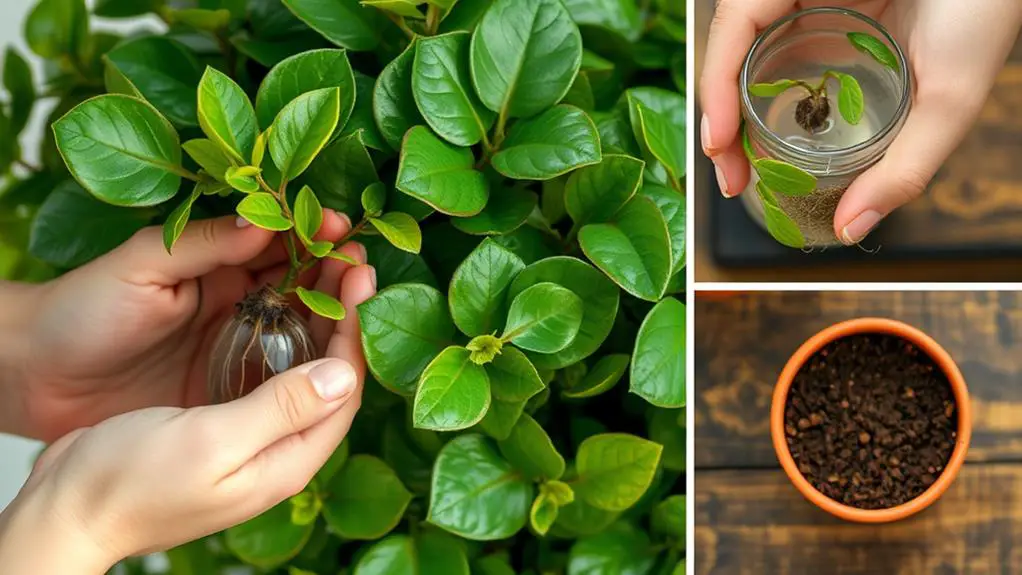
Maintaining a healthy Elephant Bush not only involves good pest and disease control but also knowing how to propagate the plant effectively. One of the best propagation methods for Elephant Bush is using stem cuttings. Here's how you can do it:
- Take stem cuttings during the active growing season (spring or summer) and make certain they're 3-5 inches long.
- Allow the cuttings to callus for 2-5 days on a paper towel or dry surface before planting them in well-draining soil.
- Place the planted cuttings in a warm, sunny location with bright indirect sunlight to encourage root development.
- Once roots have developed, usually within a few weeks, transplant the new plants into their own pots or into the garden.
Using stem cuttings is generally more successful than leaf cuttings, so stick to this method for the best results.
Remember to choose a good cactus or succulent mix to guarantee the soil drains well. Proper lighting is essential, so make certain the cuttings get enough bright, indirect sunlight.
After a few weeks, when you see root development, it's time to transplant your new Elephant Bush plants.
With these steps, you'll propagate your Elephant Bush like a pro!
Recommended Varieties

Among the many varieties of Elephant Bush, selecting the right one can enhance both your indoor and outdoor spaces. Medio-picta stands out with its variegated leaves and deep red stems, making it a visually striking choice for decorative arrangements.
When choosing recommended varieties, you should consider the unique characteristics each one offers.
Portulacaria Afra is the standard variety, often used in bonsai for its resilience and adaptability. Aurea is known for its compact form and bright yellow new leaves. This variety is perfect for smaller spaces and adds a pop of color to gardens.
If you're into bonsai, the Cork Bark variety, characterized by its unique corky texture, might be the right pick. Its distinctive appearance brings a touch of elegance.
For ground cover, search no more than Prostrata. Commonly referred to as dwarf elephant food, its glossy foliage is ideal for filling in garden spaces.
Lastly, Variegata offers creamy-edged leaves, providing an attractive option for indoor pots or garden arrangements.
Each variety has something special to offer, so think about your space and needs when making your choice.
Maintenance Tips
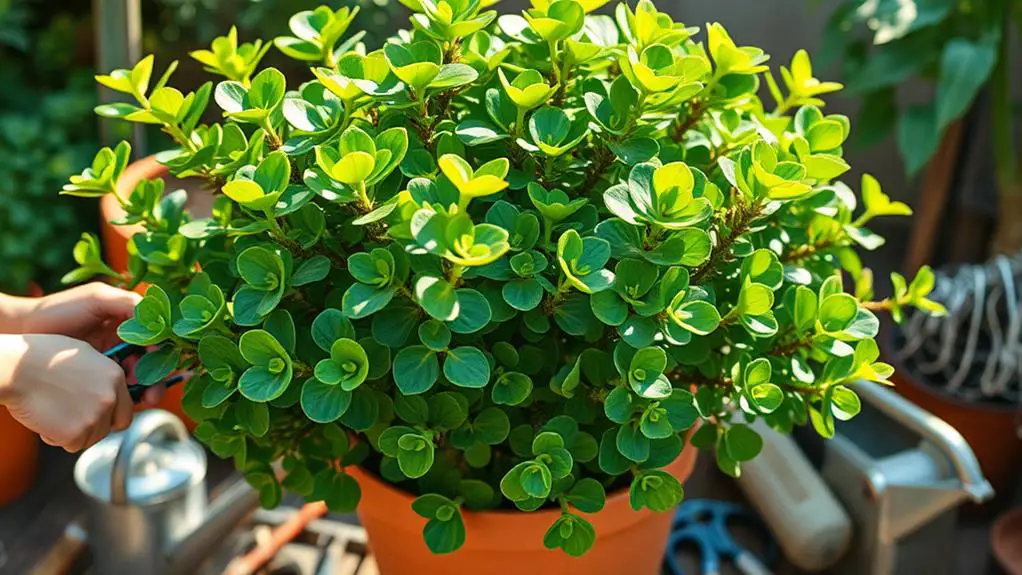
After choosing the perfect variety of Elephant Bush, it's time to guarantee it thrives with proper care. Regular maintenance is key to ensuring your plant grows healthy and strong.
Start by pruning your Elephant Bush regularly. This helps maintain its shape and encourages bushier growth. Remove any damaged or dead leaves and branches to keep the plant looking its best.
Next, you'll need to repot your Elephant Bush every 2-3 years. When it becomes rootbound, choose a pot one size larger with drainage holes. This promotes healthy growth and prevents water from sitting at the roots, which can cause rot.
Watering is essential. During the growing season, water your Elephant Bush every 2-3 weeks. Let the soil dry completely between waterings to avoid root rot. Overwatering is a common mistake, so be cautious.
Lastly, fertilize your plant with a diluted, balanced liquid fertilizer every 4-6 weeks during the growing season. Skip fertilizing during dormancy in fall and winter.
Here are some key points to remember:
- Prune regularly for shape and growth.
- Repot every 2-3 years.
- Water every 2-3 weeks, let the soil dry out.
- Fertilize during the growing season.
With these tips, your Elephant Bush can grow several feet tall and thrive beautifully!
Frequently Asked Questions
How to Properly Care for an Elephant Bush?
Make sure your Elephant Bush gets 6 hours of bright, indirect sunlight daily. Water it every 2-3 weeks, letting soil dry completely. Use well-draining soil, prune regularly, and watch for pests, treating them promptly.
Should I Mist My Elephant Bush?
You shouldn't mist your Elephant Bush because it thrives in dry conditions. Misting can lead to fungal issues and root rot. Instead, focus on proper watering and placing it in a bright, sunny spot with good air circulation.
Where to Place an Elephant Bush?
Place your Elephant Bush in a spot with at least 6 hours of bright, indirect sunlight daily. South, east, or west-facing windows work best. Outdoors, choose a dry, hot location. Avoid shaded areas to prevent stunted growth.
What Kind of Fertilizer Do Elephant Bushes Need?
Use a diluted, balanced liquid fertilizer specifically for succulents during the growing season every 4-6 weeks. Don't fertilize in winter. Follow dosage guidelines closely to avoid over-fertilization. Organic compost can be beneficial but use it sparingly.
Conclusion
Caring for your Elephant Bush can be simple and rewarding. Just remember these key tips: use well-draining soil, give it plenty of sunlight, and water it every 2-3 weeks. Keep an eye on the temperature, prune regularly, and check for pests. Don't forget to repot every few years and fertilize during the growing season. By following these steps, you'll help your plant thrive and add a touch of green to your space. You've got this!

